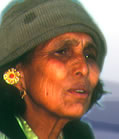 |
 |
||
 |
|||
|
GLOSSARY Nepal glossary |
transcript |
| Section 1 | "With the pond and improvement of terraces, our lives have been transformed." Our village is in Ward 1 under the Bhattedanda Village Development Committee. It is called Bhainse, and is widely known for its landslides. There was a little landslide affecting a tiny area below our village. Without warning, the land gave way close to our village. When that happened, we appealed to the Bagmati Watershed Project to do something about it. This landslide is about a kilometre from our village. In addition, there is another one on the other side. Now we have planted trees like willows, bamboo - large and small - pine and other small bushes. This has checked further erosion and at present the place does not look like a landslide area. The soil here previously was loose, brownish and wet. It eroded during both the dry and wet seasons. I was worried that this landslide would make me homeless and uproot other villagers, too. People in the past did not plant any trees, maybe because the forests met their needs. The soil also slid down because cattle were let loose on this steep terrain. Moreover, the land was not terraced. Terraces are made to level an area and to control the shifting of soil in hilly regions. Edges are raised using stones or even earth so that soil does not move down to a lower level. Terraces are maintained by rebuilding walls that have come down. The Bagmati Watershed Project provided 50 percent of the cost involved in building these terraces. In the past, we had not given much thought to the level and speed of floods. The landslide occurred because floodwater from the upper village had no other outlet and passed through here. Water from the six houses immediately above here added to that flow because there was no place else to divert it. When all that water flowed down, there was enough to run one or two water mills. We went to the Bagmati Watershed Project and requested them to build a wall with wire mesh starting at the base of the landslide. Mr. Madhukar Upadhaya, the chief of the project, told us that there was another, simpler way of controlling the slide. He built a pond to control the floodwater and constructed drains to divert floodwater as well as the overflow of the pond towards hard rocky surfaces. Since floodwater flowing past the houses above was diverted to the pond, the force of water has been considerably reduced. We are convinced that the landslide has been arrested because of this. In the past, rainwater followed the path used by people. This cut the track deep. But now that the Bagmati Watershed Project has paved the tracks, soil does not get washed away and trails have not been damaged. We are 12-15 households living at top of the landslide on both sides. But when we seek help to clean the pond, every house from other villages also sends a person for one day to assist us. The main purpose of this pond is to contain floodwater. It is also meant to cushion the impact of floodwater and to divert excess flow away from the sliding area. But it provides other advantages, too. Before this pond was built, cattle were driven at least a kilometre from here for water. Although the pond does not have water throughout the year, while it lasts it is convenient for the cattle. It has also helped villagers to irrigate their vegetable gardens. There is another aspect; we have terraced our fields. We have observed that terracing helps the soil retain moisture for longer periods. If we compare our situation before and after construction of the pond and the terracing of land, there is a marked improvement in our income and living conditions. Without the terracing, the topsoil was always washed away to the plains. Terracing has also led to an increase in crop yields. Without levelling the land, there was no possibility of growing vegetables. The roots of some vegetables do not go down deep and get exposed on sloping land where there is constant erosion. Only now we know vegetables like garlic and onions have to be cultivated on level ground. Even in the case of other crops like maize, soyabean, and mustard, we have found that in the same area of land, the yield from terraced fields is higher than that from sloping land. In the past, there were old ponds here. We thought then that they were made solely as watering holes for cattle since the water source was far away. When water came to every house, these ponds lost their value. However, having seen the worth of the present pond, I realise those ponds of the past were also made to control floods. The work of the Bagmati Watershed Project was not limited to terracing only. It also set up nurseries in different places and conducted tree plantation programmes. When seedlings became available near their houses, people planted them on their terraces and on the edges of their fields. It has considerably eased our problem of firewood and fodder for cattle. We can now afford to keep more cattle in our herds. We have more milk, which we sell to the dairy to earn money. Earlier all the houses had thatch roofs. Now everyone has put up tin roofs. This has been made possible by the improved economic conditions. The food and clothing habits of people have also undergone change. My father could just about afford a kachhad (loincloth). Now we cannot go out without trousers. I may never have worn a pair of shoes costing more than Rs. 150.00 but my son says a pair costs between Rs. 900.00 and Rs. 1,100.00. So changes have come about in what we eat and we wear. In the past we got to eat rice only during Dasain (a major Nepali festival) or at a marriage feast. At other times, our food consisted of corn gruel. Now we have stopped eating corn grit. The children don't want to eat mansuli rice (a local variety); they demand basmati (a more expensive, imported variety). We take other goods besides milk to the market. Depending on the season, we take cauliflower, radish, carrots, spinach, pumpkins, pumpkin buds, arum plants, etc., to the market. We take whatever we have in season. If we have nothing else, we take gundruk (dried spinach). Terraced fields and the water pond have changed our lives. When people look at the forest cover now, they ask in disbelief, was there a landslide here? It no longer looks like a landslide area. In the old days, in our disturbed frame of mind, we used to wonder where we could escape. Now that I think of it, I guess it was our own irresponsible actions that were to blame for the landslide. We did not arrest and check that which we could have prevented on our own; I suppose it was because of our lack of knowledge. I don't fear the landslide anymore. When I compare the situation then and now, I feel totally secure. Once I understood this, I have repeatedly told others that looking to the government for terracing is not enough, we have to do it ourselves wherever there are landslides. Terracing is extremely beneficial. My own land was not terraced. It was done later. Deforestation leads to soil erosion. Uncontrolled floodwater also results in landslides. I have suggested to people to construct terraces, build ponds and plant trees. Once we start, it isn't really very difficult. I have planted about 125 lapsi (Chinese plum trees). The will help control landslides and also add to my income. If the harvest is good, the income will be good. Of course, not all the trees will bear fruit. The branches provide enough firewood for a year. Ten, fifteen trees have begun fruiting already. We set up a bio-gas plant six years ago. We would otherwise have needed more firewood. We would have had to get that from these woods and in the process we might have destroyed many trees and saplings. The forest provides many benefits. We have received more indirect than direct benefits. |